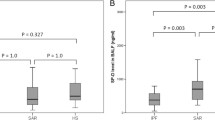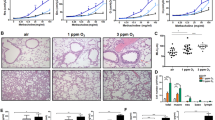Abstract
Background
Surfactant protein D (SP-D) is a collection that plays important roles in modulating host defense functions and maintaining phospholipid homeostasis in the lung. The aim of current study was to characterize comparatively the SP-D response in bronchoalveolar lavage (BAL) and serum in three murine models of lung injury, using a validated ELISA technology for estimation of SP-D levels.
Methods
Mice were exposed to lipopolysaccharide, bleomycin, or Pneumocystis carinii (Pc) and sacrificed at different time points.
Results
In lipopolysaccharide-challenged mice, the level of SP-D in BAL increased within 6 h, peaked at 51 h (4,518 ng/ml), and returned to base level at 99 h (612 ng/ml). Serum levels of SP-D increased immediately (8.6 ng/ml), peaked at 51 h (16 ng/ml), and returned to base levels at 99 h (3.8 ng/ml). In a subacute bleomycin inflammation model, SP-D levels were 4,625 and 367 ng/ml in BAL and serum, respectively, 8 days after exposure. In a chronic Pc inflammation model, the highest level of SP-D was observed 6 weeks after inoculation, with BAL and serum levels of 1,868 and 335 ng/ml, respectively.
Conclusions
We conclude that serum levels of SP-D increase during lung injury, with a sustained increment during chronic inflammation compared with acute inflammation. A quick upregulation of SP-D in serum in response to acute airway inflammation supports the notion that SP-D translocates from the airways into the vascular system, in favor of being synthesized systemically. The study also confirms the concept of using increased SP-D serum levels as a biomarker of especially chronic airway inflammation.





Similar content being viewed by others
References
Holmskov U, Thiel S, Jensenius JC (2003) Collections and ficolins: humoral lectins of the innate immune defense. Annu Rev Immunol 21:547–578
Lahti M, Lofgren J, Marttila R, Renko M, Klaavuniemi T, Haataja R et al (2002) Surfactant protein D gene polymorphism associated with severe respiratory syncytial virus infection. Pediatr Res 51:696–699
Leth-Larsen R, Nordenbaek C, Tornoe I, Moeller V, Schlosser A, Koch C et al (2003) Surfactant protein D (SP-D) serum levels in patients with community-acquired pneumonia small star, filled. Clin Immunol 108:29–37
Greene KE, Wright JR, Steinberg KP, Ruzinski JT, Caldwell E, Wong WB et al (1999) Serial changes in surfactant-associated proteins in lung and serum before and after onset of ARDS. Am J Respir Crit Care Med 160:1843–1850
Eisner MD, Parsons P, Matthay MA, Ware L, Greene K (2003) Plasma surfactant protein levels and clinical outcomes in patients with acute lung injury. Thorax 58:983–988
Betsuyaku T, Kuroki Y, Nagai K, Nasuhara Y, Nishimura M (2004) Effects of ageing and smoking on SP-A and SP-D levels in bronchoalveolar lavage fluid. Eur Respir J 24:964–970
Cheng G, Ueda T, Numao T, Kuroki Y, Nakajima H, Fukushima Y et al (2000) Increased levels of surfactant protein A and D in bronchoalveolar lavage fluids in patients with bronchial asthma. Eur Respir J 16:831–835
Noah TL, Murphy PC, Alink JJ, Leigh MW, Hull WM, Stahlman MT et al (2003) Bronchoalveolar lavage fluid surfactant protein-A and surfactant protein-D are inversely related to inflammation in early cystic fibrosis. Am J Respir Crit Care Med 168:685–691
Postle AD, Mander A, Reid KB, Wang JY, Wright SM, Moustaki M et al (1999) Deficient hydrophilic lung surfactant proteins A and D with normal surfactant phospholipid molecular species in cystic fibrosis. Am J Respir Cell Mol Biol 20:90–98
Honda Y, Kuroki Y, Matsuura E, Nagae H, Takahashi H, Akino T et al (1995) Pulmonary surfactant protein D in sera and bronchoalveolar lavage fluids. Am J Respir Crit Care Med 152:1860–1866
Honda Y, Takahashi H, Kuroki Y, Akino T, Abe S (1996) Decreased contents of surfactant proteins A and D in BAL fluids of healthy smokers. Chest 109:1006–1009
Lomas DA, Silverman EK, Edwards LD, Locantore NW, Miller BE, Horstman DH et al (2009) Serum surfactant protein D is steroid sensitive and associated with exacerbations of COPD. Eur Respir J 34:95–102
Guo CJ, Atochina-Vasserman EN, Abramova E, Foley JP, Zaman A, Crouch E et al (2008) S-nitrosylation of surfactant protein-D controls inflammatory function. PLoS Biol 6:e266
Atochina-Vasserman EN (2012) S-nitrosylation of surfactant protein D as a modulator of pulmonary inflammation. Biochim Biophys Acta 1820:763–769
Winkler C, Atochina-Vasserman EN, Holz O, Beers MF, Erpenbeck VJ, Krug N et al (2011) Comprehensive characterisation of pulmonary and serum surfactant protein D in COPD. Respir Res 12:29
Mutti A, Corradi M, Goldoni M, Vettori MV, Bernard A, Apostoli P (2006) Exhaled metallic elements and serum pneumoproteins in asymptomatic smokers and patients with COPD or asthma. Chest 129:1288–1297
Hirama N, Shibata Y, Otake K, Machiya J, Wada T, Inoue S et al (2007) Increased surfactant protein-D and foamy macrophages in smoking-induced mouse emphysema. Respirology 12:191–201
Homer RJ, Zheng T, Chupp G, He S, Zhu Z, Chen Q et al (2002) Pulmonary type II cell hypertrophy and pulmonary lipoproteinosis are features of chronic IL-13 exposure. Am J Physiol Lung Cell Mol Physiol 283:52–59
Ikegami M, Whitsett JA, Chroneos ZC, Ross GF, Reed JA, Bachurski CJ et al (2000) IL-4 increases surfactant and regulates metabolism in vivo. Am J Physiol Lung Cell Mol Physiol 278:75–80
Sorensen GL, Husby S, Holmskov U (2007) Surfactant protein A and surfactant protein D variation in pulmonary disease. Immunobiology 212:381–416
Kingma PS, Zhang L, Ikegami M, Hartshorn K, McCormack FX, Whitsett JA (2006) Correction of pulmonary abnormalities in Sftpd-/- mice requires the collagenous domain of surfactant protein D. J Biol Chem 281:24496–24505
Hansen S, Schmidt V, Steffensen MA, Jensen PH, Gjerstorff M, Thiel S et al (2008) An enzyme-linked immunosorbent assay (ELISA) for quantification of mouse surfactant protein D (SP-D). J Immunol Methods 330:75–85
Hollingsworth JW, Cook DN, Brass DM, Walker JK, Morgan DL, Foster WM et al (2004) The role of Toll-like receptor 4 in environmental airway injury in mice. Am J Respir Crit Care Med 170:126–132
Fujita M, Shannon JM, Ouchi H, Voelker DR, Nakanishi Y, Mason RJ (2005) Serum surfactant protein D is increased in acute and chronic inflammation in mice. Cytokine 31:25–33
Atochina-Vasserman EN, Gow AJ, Abramova H, Guo CJ, Tomer Y, Preston AM et al (2009) Immune reconstitution during Pneumocystis lung infection: disruption of surfactant component expression and function by S-nitrosylation. J Immunol 182:2277–2287
Casey J, Kaplan J, Atochina-Vasserman EN, Gow AJ, Kadire H, Tomer Y et al (2005) Alveolar surfactant protein D content modulates bleomycin-induced lung injury. Am J Respir Crit Care Med 172:869–877
Atochina EN, Beck JM, Scanlon ST, Preston AM, Beers MF (2001) Pneumocystis carinii pneumonia alters expression and distribution of lung collectins SP-A and SP-D. J Lab Clin Med 137:429–439
Braber S, Verheijden KA, Henricks PA, Kraneveld AD, Folkerts G (2010) A comparison of fixation methods on lung morphology in a murine model of emphysema. Am J Physiol Lung Cell Mol Physiol 299:843–851
Selman L, Skjodt K, Nielsen O, Floridon C, Holmskov U, Hansen S (2008) Expression and tissue localization of collectin placenta 1 (CL-P1, SRCL) in human tissues. Mol Immunol 45:3278–3288
Madsen J, Kliem A, Tornoe I, Skjodt K, Koch C, Holmskov U (2000) Localization of lung surfactant protein D on mucosal surfaces in human tissues. J Immunol 164:5866–5870
Beers MF, Atochina EN, Preston AM, Beck JM (1999) Inhibition of lung surfactant protein B expression during Pneumocystis carinii pneumonia in mice. J Lab Clin Med 133:423–433
Suda K, Tsuruta M, Eom J, Or C, Mui T, Jaw JE et al (2011) Acute lung injury induces cardiovascular dysfunction: effects of IL-6 and budesonide/formoterol. Am J Respir Cell Mol Biol 45:510–516
Zhang F, Pao W, Umphress SM, Jakowlew SB, Meyer AM, Dwyer-Nield LD et al (2003) Serum levels of surfactant protein D are increased in mice with lung tumors. Cancer Res 63:5889–5894
Haczku A, Atochina EN, Tomer Y, Chen H, Scanlon ST, Russo S et al (2001) Aspergillus fumigatus-induced allergic airway inflammation alters surfactant homeostasis and lung function in BALB/c mice. Am J Respir Cell Mol Biol 25:45–50
Pan T, Nielsen LD, Allen MJ, Shannon KM, Shannon JM, Selman M et al (2002) Serum SP-D is a marker of lung injury in rats. Am J Physiol Lung Cell Mol Physiol 282:824–832
Atochina EN, Beers MF, Scanlon ST, Preston AM, Beck JM (2000) P. carinii induces selective alterations in component expression and biophysical activity of lung surfactant. Am J Physiol Lung Cell Mol Physiol 278:599–609
Holmskov U (1999) Lung surfactant proteins (SP-A and SP-D) in non-adaptive host responses to infection. J Leukoc Biol 66(5):747–752
Gardai SJ, Xiao YQ, Dickinson M, Nick JA, Voelker DR, Greene KE et al (2003) By binding SIRPalpha or calreticulin/CD91, lung collectins act as dual function surveillance molecules to suppress or enhance inflammation. Cell 115:13–23
Acknowledgments
We thank technicians Jette Brandt (University of Southern Denmark) and Vivi Schmidt (University of Southern Denmark) for help with establishing and continuously validating the SP-D ELISA. We thank professors W. Michael Foster and Jo Rae Wright (Duke University Medical Center) for help with establishing the Hinner exposure chamber and protocol for LPS exposure. This study was part of a Ph.D. study supported financially by the Department of Otorhinolaryngology, Odense University Hospital, University of Southern Denmark and the Region of Southern Denmark. We thank the Hoejbjerg Foundation and the A.P. Moeller Foundation for financial support to obtain materials and reagents. This work was supported by NIH ES P30-013508. The supporting organizations had no part in the protocol or conductance of the study and had no financial interest in the outcome.
Conflict of interest
The authors have no conflicts of interest to disclose.
Author information
Authors and Affiliations
Corresponding author
Additional information
M. Q. Gaunsbaek and K. J. Rasmussen contributed equally to this study.
Rights and permissions
About this article
Cite this article
Gaunsbaek, M.Q., Rasmussen, K.J., Beers, M.F. et al. Lung Surfactant Protein D (SP-D) Response and Regulation During Acute and Chronic Lung Injury. Lung 191, 295–303 (2013). https://doi.org/10.1007/s00408-013-9452-x
Received:
Accepted:
Published:
Issue Date:
DOI: https://doi.org/10.1007/s00408-013-9452-x




